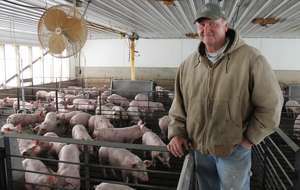With a new pork processing plant trying to build a new state-of-the-art plant in a town 45 miles north of me, it seems to have stirred up a storm about modern livestock production again. I really thought pig farmers like me were doing a very thorough job of explaining why we farm the way we do, but apparently we have more work to do!
That’s why today I’m writing about some of the methodical processes I undertake on a daily basis to help update sow farms across the Midwest. After raising hogs for more than 50 years, I’ve returned fulltime to the construction side of pig farming. Currently I’m supervising a large remodel project on gestation barns for a family operation.
Gestation barns are where the momma pigs return after their litters of pigs are weaned. We want to provide as much comfort as possible and reduce stress for these sows whose litters have been newly weaned. I’m not going to use a word such as happy when I talk about an animal because too many people think of an animal in people terms. However, I put this in terms of animal health and care.
A very critical time when caring for sows is right after their pigs have been weaned. Animals need to be as “stress” free as possible, so animal comfort is a one of our primary goals. That’s why the timing of weaning is so important. Before weaning pigs, farmers must consider: (1) What is best for the little pigs; (2) When the little pigs can start eating feed; and (3) The time that is it best for the sow.
All of these questions are being considered as we remodel the gestation buildings because taking the very best care of the sow pigs is critical to the success of a pig operation.
Another critical part of my job is disease control. About 30 construction workers are working on the remodel, so we must make sure a disease isn’t brought in to this sow herd. If there are sows in the rooms where we are working, my workers must “shower in.” This process means a worker cannot bring even a cell phone in to the sow unit. The tool and parts we need must be disinfected and then wrapped in a tarp overnight to make sure potential diseases are killed.
Pigs are removed as we remodel the barns. While this helps us get the work done, we’re also feeling the pressure to finish the work on schedule. If the barn remodel isn’t done on time, the cycle will be disrupted. The farrowing rooms won’t be kept full and our efficiency will decrease. Empty birthing rooms equal lost production for pig farmers, and it affects our operation all the way through the nursery and finish barns.
Our company is committed to deliver a certain number of pigs to market, so the processing plants can run smoothly and efficiently. (See how the entire industry is intertwined?) We’re also trying to break disease cycles simply by keeping barns empty and disinfecting them, just like an operating room in a hospital!
I’ve talked before about all the systems (feed, water and air) that it takes to keep our pigs in a stress-free environment. Hopefully, today’s blog helps explains more about how complex it really is. It takes extensive work to do what’s right for our pigs, the environment and our people!

